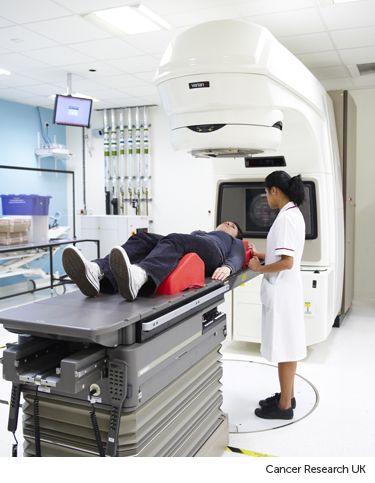Radiotherapy treatment for pleural mesothelioma
Radiotherapy uses high energy x-rays to treat cancer cells. You might have radiotherapy for mesothelioma.
You have radiotherapy in a hospital radiotherapy department. You usually have it as an outpatient each weekday. You might only have 1 or 2 treatments. Or you might have a course of treatment over a few days or weeks, depending on your situation.
Some hospitals have rooms near the hospital you can stay in if you have a long way to travel.
When you might have it
You might have radiotherapy to reduce the symptoms of pleural mesothelioma. The treatment may also slow down the growth of your tumour.
You might have radiotherapy after surgery for pleural mesothelioma. This is called adjuvant radiotherapy. It aims to stop or delay the cancer from coming back.
You don't usually have radiotherapy for peritoneal mesothelioma. This is because it causes too many side effects.
The radiotherapy room
Radiotherapy machines are very big and could make you feel nervous when you see them for the first time. The machine might be fixed in one position. Or it might rotate around your body to give treatment from different directions. The machine doesn't touch you at any point.
Before your first treatment, your  will explain what you will see and hear. In some departments, the treatment rooms have docks for you to plug in music players. So, you can listen to your own music while you have treatment.
will explain what you will see and hear. In some departments, the treatment rooms have docks for you to plug in music players. So, you can listen to your own music while you have treatment.

Before each treatment session
The radiographers help you to get onto the treatment couch. You might need to raise your arms over your head.
The radiographers line up the radiotherapy machine using the marks on your body. Once you are in the right position, they leave the room.
During the treatment
You need to lie very still. Your radiographers might take images (x-rays or scans) before your treatment to make sure that you're in the right position. The machine makes whirring and beeping sounds. You won’t feel anything when you have the treatment.
Your radiographers can see and hear you on a CCTV screen in the next room. They can talk to you over an intercom and might ask you to hold your breath or take shallow breaths at times. You can also talk to them through the intercom or raise your hand if you need to stop or if you're uncomfortable.
You won't be radioactive
This type of radiotherapy won't make you radioactive. It's safe to be around other people, including pregnant women and children.
Travelling to radiotherapy appointments
You might have to travel a long way each day for your radiotherapy. This depends on where your nearest cancer centre is. This can make you very tired, especially if you have side effects from the treatment.
You can ask the  for an appointment time to suit you. They will do their best, but some departments might be very busy. Some radiotherapy departments are open from 7 am till 9 pm.
for an appointment time to suit you. They will do their best, but some departments might be very busy. Some radiotherapy departments are open from 7 am till 9 pm.
Car parking can be difficult at hospitals. Ask the radiotherapy staff if you are able to get free parking or discounted parking. They may be able to give you tips on free places to park nearby.
Hospital transport may be available if you have no other way to get to the hospital. But it might not always be at convenient times. It is usually for people who struggle to use public transport or have any other illnesses or disabilities. You might need to arrange hospital transport yourself.
Some people are able to claim back a refund for healthcare travel costs. This is based on the type of appointment and whether you claim certain benefits. Ask the radiotherapy staff for more information about this and hospital transport.
Some hospitals have their own drivers and local charities might offer hospital transport. So do ask if any help is available in your area.
Side effects
You are unlikely to get side effects from radiotherapy to control your symptoms.
You may have side effects if you have a few weeks of radiotherapy treatment after surgery for early mesothelioma. The most common side effects are reddening of the skin and loss of hair in the treatment area.



